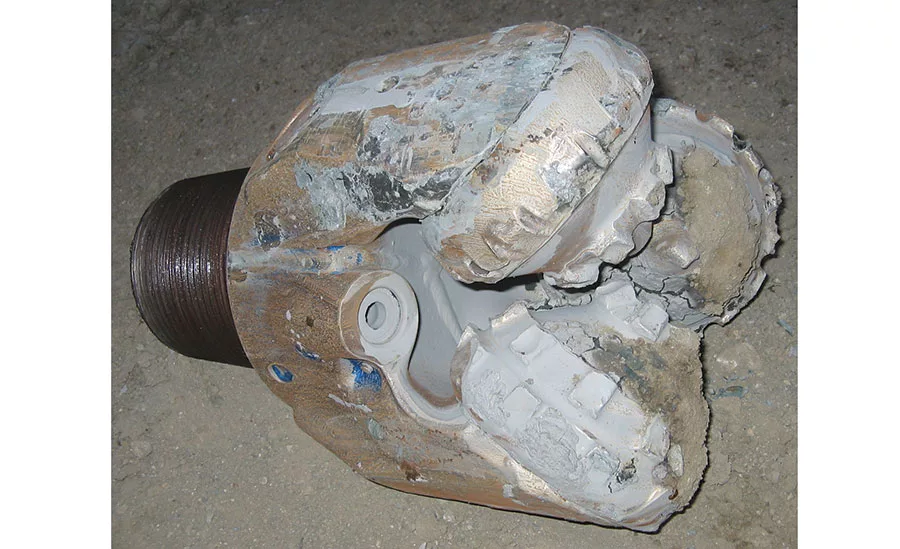For Drilling Jobs, Bit Selection and Mud Flow Can Head Off Balling

Tri-cone bits can fall prey to balling, particularly in clays. Source: U.S. Geological Survey
I don’t know why things come in cycles, but they sure seem to. This spring, I’ve had more than a couple calls and emails from drillers about bit balling problems and solutions. Bit balling is when the formation balls up around the cutters on a tri-cone bit until the wheels won’t turn and the bit quits drilling. Usually it is in a sticky clay formation, but not always. Bits can ball up in almost any formation due to a variety of reasons. Fixed cutter bits can also ball up.
The first step is prevention. Make sure you are running the right bit. On the last one I looked at, the driller had run a short, button bit in clay. The buttons were not long enough to remove the formation ahead of the bit, and it balled up. He changed to a tooth bit, and problem solved. Button bits are made for harder formations and remove material mostly by impact. A tooth bit drills by a combination of gouging and scraping, which is a different dynamic. So bit selection is critical. Very soft and plastic clays need pretty long teeth to do the job. As the formation gets harder, the teeth get shorter until it’s time to put on a button.
Some of the factors that affect bit performance are weight on bit, rotary speed, mud flow and mud rheology. Balling is characterized by decreased, or no, penetration, and usually lower torque.
Weight on bit is a common cause of bit balling. Too much weight, and the bit is forced ahead of where it can remove material. This will ball a bit quickly. In softer formations, decrease the weight and increase the rotary speed. This lets the bit make smaller cuttings and work in its optimum zone.
Closely related is mud flow. If the flow is too low, the bit will not be cleared of drilled formation as fast as it is drilled. This will ball a bit every time. In sticky clays, increase the mud flow as much as you can to keep the bit clear. This can be difficult with centrifugal pumps, as the pack off around the bit can effectively shut off circulation. With piston pumps, you will often see a pressure increase as the bit or stabilizers pack off, but this can be aided by increased mud flow to help clear the bit.
Fixed insert bits and wing bits can also ball up. This is usually because of too much weight, not enough rpms or not enough mud flow. Usually a combination of the three. A bit will not drill any faster than it can remove formation and send it up the hole.
If you do suspect that your bit is balling up there are several things that can be done before you come out of the hole to clean it. First, pick up until there is very little weight on bottom. Increase your pump rate as much as you can and spin the rotary as fast as you feel safe. Stroke the pipe up and down, bumping bottom each time. This will surge the mud around the bit and tend to free up the cones. If the formation is solid, don’t be afraid to drop the pipe pretty fast. This temporarily increases flow and pressure at the bit. This will tend to wash the ball off. Next, thin the mud. Since you are probably in a clay formation, you won’t need much wall cake. A clay hole will usually stand up pretty good.
One of the reasons clay balls up is due to its chemistry. Clay particles have an electrical charge, one end being positive and one end being negative. Since opposite charges attract, as soon as the clay particle is drilled up, it will try to reassemble itself. The cure for this is to strip the charge off the cuttings as soon as possible with the right mud properties. Commonly used and available is sodium tetraphosphate. Baroid sells it as Bara-Phos. Your mud dealer may have it. If not and you are in a bind, use Cascade dishwasher detergent. It contains sodium tetraphosphate and soda ash. Pour a half box in the drill pipe and watch your returns. They’ll thin right out. And it will help with the bit balling. Other cures include ground walnut shells. This is a common oilfield trick that helps prevent balls by cutting them up as they form. The oilfield has a lot of pretty good tricks, but they are a little beyond what we need for most water wells, and might not be legal. If nothing else works, you are probably going to have to pull out of the hole and clean the bit. Look closely at the cones; if they haven’t been turning for a while because of the ball, the bit may have flat-spotted and you may have to replace it. If you run it back, make sure all the wheels are free.
Hope this helps. If ya need some free advice, send me an email. Remember, free advice is usually worth what you pay for it.
For more Wayne Nash columns, visit www.thedriller.com/wayne.
Looking for a reprint of this article?
From high-res PDFs to custom plaques, order your copy today!

